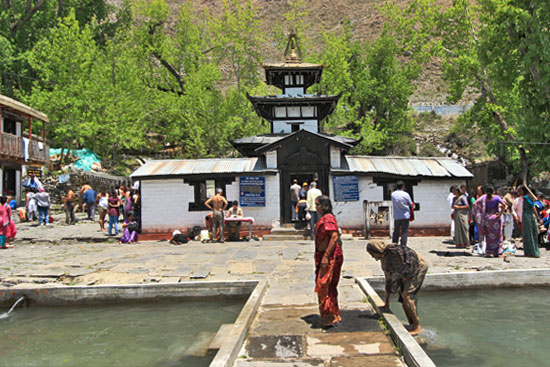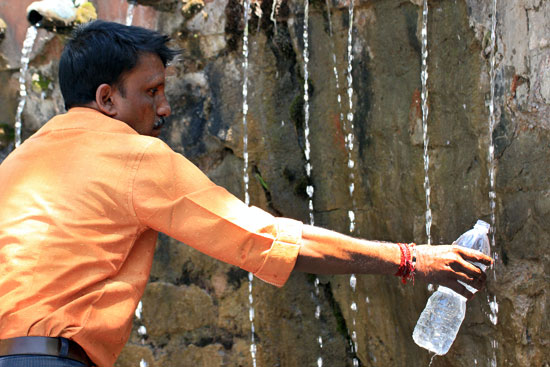More than worrying about whether I would be able to carry my heavy backpack while trekking the Lower Mustang area in the Himalaya Mountains of Nepal, I was concerned about altitude sickness. I had learned the hard way during a two month visit to Ecuador late last year that I do not react well to elevations over 10,000 feet. Though I was fine in Jomsom, Kagbeni, and Marpha, all of which are at lower elevations, the town of Muktinath lies nearly 12,500 feet high, and the temple of the same name is 300 feet higher than the town. Just to be safe, I popped a high-altitude sickness pill the night before and opted for a 4WD jeep rather than making the four-hour trek each way.
As directed, I arrived at 8:30 a.m. and was told the jeep would be delayed until 9:30. Two hours later, I was still waiting; the jeep needs a minimum of 12 passengers to make the run and since I had opted to travel in the low season no other customers had arrived. Fearing that I would miss my opportunity to visit Muktinath altogether, I pressed the issue and the manager finally pointed to a rough, rocky trail leading to the upper reached of Kagbeni. “You go top, get jeep.” Fortunately I had done some day-trekking around the area and knew the road to Muktinath was in the general direction where he pointed, so I scrambled up to the top of town and stuck my thumb out. Sure enough, a dust-caked jeep soon jounced around a corner and rumbled to a stop in front of me. “Muktinath?” I asked. The driver hopped out and unchained the back door of the jeep; I squeezed in with a family on Indians on a pilgrimage to visit the temple.
For the next hour our hotshot driver threaded a needle between soaring cliffs on one side of the rough graveled track and precipitous drop-offs that plunged thousands of feet to the valley floor, at times taking curves at a frightening speed that had us all banging on the roof for him to slow down. When the jeep finally rolled into town we breathed a collective sigh of relief and shakily climbed out.

My rubbery legs carried me through the tiny village, not much more than a handful of brightly-painted wooden structures, to the trail that ascended to the temple itself. Halfway up I turned and looked down upon Muktinath, regally backed by a purple and blue Himalayas that took away what little breath remained in my straining lungs. At the entrance I silently congratulated myself and collapsed on the ground next to a group of Sadhus (Hindu holy men) dressed in orange robes and painted white with Shiva’s ashes. With my limited Nepali vocabulary and their few words of English, we exchanged pleasantries until I was somewhat acclimated to the elevation and was able to continue my upward journey. Twenty minutes later I mounted the final staircase and stepped into a broad courtyard where fully clothed worshipers were immersing in two waist-high pools of water in front of the unassuming temple. Amidst much shrieking and merriment, husbands coerced their wives into the ice-cold water and fathers carried their children across the pools, stopping for a quick dip in the center of the pool.

Despite crystal clear sunshine and warm midday temperatures, the water temperature remains near freezing year-round, as its source is a spring that wells up from the mountain behind the temple. The water is captured and diverted into 108 fountains in the shape of bull’s heads, where it runs everlastingly into a three-sided enclosure that surrounds Muktinath Temple. After immersion into the pools, faithful make a run through these fountains as well, again in most cases fully clothed, though some of the men unashamedly stripped down to the briefest of skivvies.

Not willing to subject my camera to a dousing, I joined the line of pilgrims waiting to enter the inner sanctum of the temple. Considered by Hindus to be one of the eight most sacred sites in the world, Muktinath is also an extremely important site to Tibetan Buddhists, who call it Chumig Gyatsa, which means ‘Hundred Waters’ in Tibetan. For Tibetans, Muktinath is one of the 24 Tantric places in the world and home to the Dakinis, goddesses known as Sky Dancers. Narsingh Gompa, a smaller temple within the larger Muktinath site, holds a golden icon said to be a manifestation of Avalokitesvara, a bodhisattva who embodies the compassion of all Buddhas and of whom the current Dalai Lama is said to be an emanation. Tibetan Buddhist tradition also states that Padmasambhava, the founder of Tibetan Buddhism better known as Guru Rinpoche, meditated at Muktinath on his way to Tibet.
Can’t view the above slide show about Muktinath, Nepal? Click here.
However, I was not at the revered Buddhist site; I was waiting to enter the main temple, which is holy to Hindus. As I passed through the exterior structure that encloses the actual temple, a stern-faced officer in blue camouflage uniform stopped me with an upraised palm. “Only go to doorway. Look inside, not go inside!” Once again, as with Pashupatinath Temple in Kathmandu, it seemed I was going to be denied entry. Rather than try to sneak in, which had decidedly not worked at Pashupati, I took a different tack this time. Flashing him a big smile, I nodded graciously and said in Nepali, “Maw Buddhist ho.” I am Buddhist. His brooding demeanor vanished, replaced by a wide, gold-toothed grin. Twirling his wooden baton, he glued himself to my side as we slowly approached the doorway. At the threshold he motioned for me to stick my head inside, then pointed to the metal statues, naming each in succession: Lord Vishnu, goddess Laxmi, Saraswoti, Janaki, Garuda, Lava-Kush and Sapta Rishis.

Back outside I made one more circuit of the 108 fountains, where faithful were filling plastic bottles to take home for future prayers and ritual cleansing. I had brought nothing to fill, but I reached inside the metal railing, caught some of the holy water in my cupped palm, and tossed it over my head and shoulders. I’ll take all the blessing I can get. Considering that a year ago I thought I would never be able to trek again, something is working. Who am I to doubt the mysterious workings of the universe?

Muktinath is situated in high Himalayan zone of Nepal, on an altitude of 3800 meters in Mustang district amidst some of the high mountain ranges like Dhaulagiri , Annapurna. The Temple is situated on a high ground outskirt of village Rani Purwa. River Kaligandaki flows just below Muktinath.
I was there earlier this year, meditated alone in the Buddhist Temple. Spent almost the whole day exploring there. Beautiful experience. Thank you for sharing yours
You’re so very welcome Helene. It as such a remarkable place and I’m grateful to have experienced it.
Update about Muktinath. Bridge to cross the Kaligandaki River at Jomsom has been built. Now pilgrimage doesn’t require to change the jeep at Jomsom. They can directly reach to Muktinath Temple via single jeep from Pokhara and takes 12 hours.
Thanks so much for sharing that bit of information, Yatri. Very helpful!
Thank you Barbara for your beautiful, detailed writing – it is giving me the confidence and courage to make the journey!
Hi Jane: I know you’re back now and it seems like Muktinath was everything you hoped it would be. So happy I helped you do this.
Hi! Found your blog through online search. Chicago resident who hopes to make the trip to Muktinath this year. How long did you need to adjust the altitude change? This is my biggest concern of going up to high altitudes. I really want to see this temple 🙂
Hi Ravi: Well, I get altitude sickness at 4,000 meters, so I have to be careful. I based in Kagbeni, which is just slightly lower than that, doing day treks in the area to acclimatize. A few days later I took a jeep to Muktinath, which is slightly above 4,000 meters, but I was OK because I’d spent some time getting used to the altitude.
Hi! Ravi, Muktinath Temple is situated at an altitude of 3710 meters above sea-level and barely people get altitude sickness here. My suggestion is to first stay one overnight at Jomsom before heading to Muktinath for acclimatization. Then, next day you can visit Muktinath Temple without worry. Drink lots of water and if possible garlic soup is better to overcome the altitude sickness.
Muktinath Temple is the holiest place where according to Hindu Myth, the lord god Vishnu incarnated in Shaligram due to the course of Brinda (wife of Jalandhar). Hindu called it Muktinath Dham and Chumig Gyatsa by Buddhist. Therefore this temple is symbol of the religious symbiosis between both Hindus and Buddhists. For more details on this temple please visit this site Muktinath Temple.
Hi Nipendra: Thanks for sharing the website on Muktinath, and for your explanation about why the site is so holy.
I pray to God Mukthinath to bless me to visit his abode.
I hope you get your wish R. Ramaswami.
im going to visit the temple in june 4th week of this year
I’m jealous Jaya – have a wonderful trip!
Such a great story!what an incredible experience! It would be impossible to leave a place like that untouched in some way…
Hi Niraj: I’m a Buddhist, and of course, there is a strong relationship between Buddhism and Hinduism. In the case of Muktinath, that relationship is especially strong, as it has been visited by the Karmapa, so it was very special for me.
It’s really a great travel. How I wish I could go there and visit that Holy temple.
What an inspiring story and a great experience. I like the way that two major religions can to a certain extent share a sacred site – not always a comfortable arrangement. I love your detail of the ritual as cold as it must be. The fountains remind me of a beautiful garden in Rome lined with fountains though not for walking through.
Such a great story! I’m so glad you were able to get in once you told him you’re Buddhist. Those photos are gorgeous. I’m not sure I could ever stop gazing at the mountains if I were there.
This post really resonated with me. I always loved visiting Nepal. Despite the noise and dirt of Thanel, Nepal has that goddess-y spiritual energy
Thanks Barbara, for such a detailed description with images, we plan for the next week darshan ant this helps a lot, I am with my mother ( 62 yrs) age, we go there by flight to Jomsom, some says Jeep goes up to temple entrance, is this true?
Its not possible to walk much.
Hi Pranay: The jeeps go to the entrance of town only but at the foot of the stairs leading to the hilltop Muktinath temple there are a fleet of motorcycles waiting to carry anyone who cannot do the stairs up to the top. The only problem might be how to get from the entranvce of town to the foot of the stairs, since it’s about a half mile walk, however I’m guessing you could hire a motorcycle to take you and your mother all the way.
Did all those fountains and pools remind you of the baths in Banos except no warm ones to counteract the freezing ones?
LOL, Heather. I hadn’t thought about it but they DO look like the fountains at Banos, minus the heated pools.
That’s how I felt at the temples I visited in Tokyo… just something about the experience that seems to speak to you on a really deep and meaningful level!
Wow what an incredible experience! It would be impossible to leave a place like that untouched in some way…